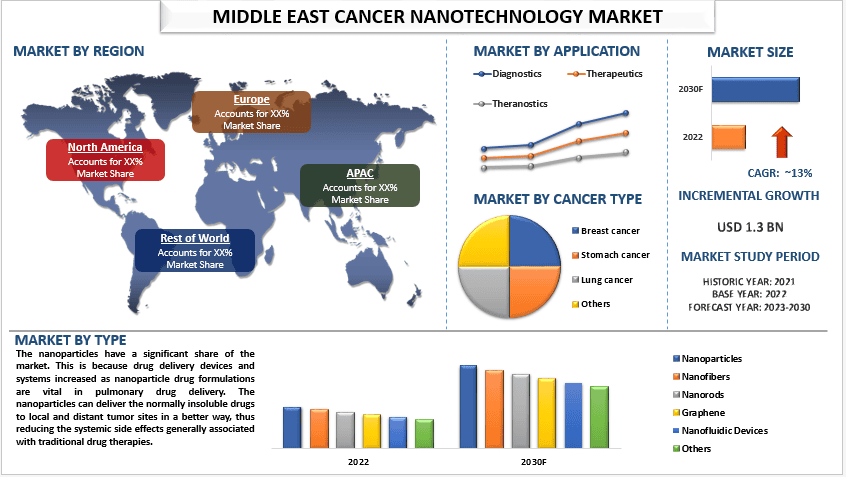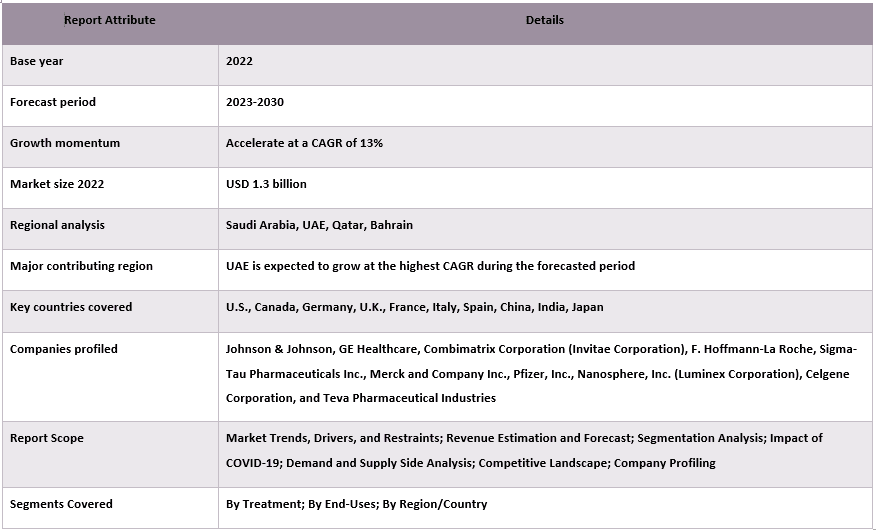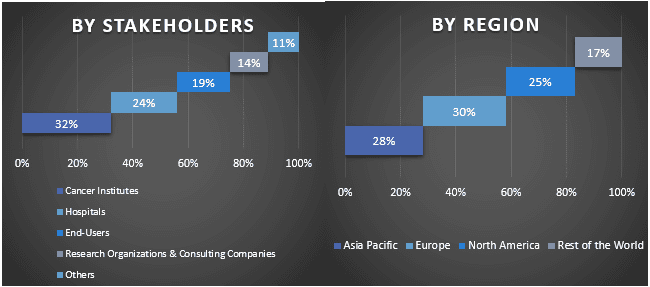- Home
- About Us
- Industry
- Services
- Reading
- Contact Us
Middle East Cancer Nanotechnology Market: Current Analysis and Forecast (2023-2030)
Emphasis on Type (Nanoparticles, Nanofibers, Nanorods, Graphene, Nanofluidic Devices, and Others); Application (Diagnostics, Therapeutics, and Theranostics); Cancer Type (Breast Cancer, Stomach Cancer, Lung Cancer, and Others); and Region/Country

The Middle East Cancer Nanotechnology market was valued at USD 1.3 billion in the year 2022 and is expected to grow at a strong CAGR of around 13% during the forecast period 2023-2030. Nanotechnology offers the means to target therapies directly and selectively for cancerous cells and neoplasms. With these tools, clinicians can safely and effectively deliver chemotherapy, radiotherapy, and the next generation of immuno- and gene therapies to the tumor. Furthermore, government initiatives and policies aimed at improving cancer care and addressing rare diseases have contributed to the growth of the market. For instance, in August 2023, the National Comprehensive Cancer Network® (NCCN®) – an alliance of leading cancer centers announced that a library of resources to improve cancer care in the Middle East and North Africa (MENA) has been updated and expanded in collaboration with experts from the region. The US-based nonprofit has been working with King Abdulaziz Medical City in Riyadh, Saudi Arabia, since 2015 to standardize cancer treatment based on the latest evidence and expert consensus. within the framework of the regional coordination center MENA-NCCN.
Some of the major players operating in the market include Johnson & Johnson, GE Healthcare, Combimatrix Corporation (Invitae Corporation), F. Hoffmann-La Roche, Sigma-Tau Pharmaceuticals Inc., Merck and Company Inc., Pfizer, Inc., Nanosphere, Inc. (Luminex Corporation), Celgene Corporation, and Teva Pharmaceutical Industries. Several M&As along with partnerships have been undertaken by these players to facilitate customers with hi-tech and innovative products/technologies.
Insights Presented in the Report
“Amongst type, the nanoparticles segment held a significant share of the market in 2022.”
Based on type, the market is segmented into nanoparticles, nanofibers, nanorods, graphene, nanofluidic devices, and others. Among these, nanoparticles have a significant share of the market in 2022. This is because drug delivery devices and systems increased as nanoparticle drug formulations are vital in pulmonary drug delivery. The nanoparticles can deliver the normally insoluble drugs to local and distant tumor sites in a better way, thus reducing the systemic side effects generally associated with traditional drug therapies.
“Amongst application, the diagnostics segment held a significant share of the market in 2022.”
Based on application, the market is segmented into diagnostics, therapeutics, and theranostics. Among these, diagnostics has a high market share in 2022 and will dominate during the forecast period. This is due to the rise in the adoption of nanotechnology in medical diagnosis and imaging is increasing the market growth demand. In biomedical research, nanotechnology is widely used against COVID-19, as in numerous vaccinations that use nanoparticles as a treatment based on the encapsulation of the active ingredient of certain medications. Numerous nanosystems have been found to be better candidates for therapeutic purposes than conventional ones. Thus, this factor boosts market growth.
“Amongst cancer type, breast cancer segment held the higher CAGR in the market in 2022.”
Based on the cancer type, the market is segmented into breast cancer, stomach cancer, lung cancer, and others. Among these, breast cancer will attain a high market share during the forecast period. Breast cancer held more than 60% share in the market owing to the presence of a wide range of nanotechnology for the management of breast cancer and the surge in the prevalence of breast cancer.
“Saudi Arabia dominated the Middle East Cancer Nanotechnology market in 2022”
In Saudi Arabia, the cancer nanotechnology market is being driven by a number of factors, including a growing demand for advanced cancer treatments, an increase in research and development activity in the field, and the presence of a number of well-funded organizations and institutions working on cancer nanotechnology.
Middle East Cancer Nanotechnology Market Report Coverage

Reasons to buy this report:
- The study includes market sizing and forecasting analysis validated by authenticated key industry experts.
- The report presents a quick review of overall industry performance at one glance.
- The report covers an in-depth analysis of prominent industry peers with a primary focus on key business financials, product portfolios, expansion strategies, and recent developments.
- Detailed examination of drivers, restraints, key trends, and opportunities prevailing in the industry.
- The study comprehensively covers the market across different segments.
- Deep dive regional level analysis of the industry.
Customization Options:
The global Middle East Cancer Nanotechnology market can further be customized as per the requirement or any other market segment. Besides this, UMI understands that you may have your own business needs, hence feel free to contact us to get a report that completely suits your requirements.
Table of Content
Research Methodology for the Middle East Cancer Nanotechnology Market Analysis (2023-2030)
Analyzing the historical market, estimating the current market, and forecasting the future market of the global Middle East cancer nanotechnology market were the three major steps undertaken to create and analyze the adoption of Middle East cancer nanotechnology in major regions globally. Exhaustive secondary research was conducted to collect the historical market numbers and estimate the current market size. Secondly, to validate these insights, numerous findings and assumptions were taken into consideration. Moreover, exhaustive primary interviews were also conducted, with industry experts across the value chain of the Middle East cancer nanotechnology market. Post assumption and validation of market numbers through primary interviews, we employed a top-down/bottom-up approach to forecasting the complete market size. Thereafter, market breakdown and data triangulation methods were adopted to estimate and analyze the market size of segments and sub-segments of the industry pertains to. Detailed methodology is explained below:
Analysis of Historical Market Size
Step 1: In-Depth Study of Secondary Sources:
Detail secondary study was conducted to obtain the historical market size of the Middle East cancer nanotechnology market through company internal sources such as annual reports & financial statements, performance presentations, press releases, etc., and external sources including journals, news & articles, government publications, competitor publications, sector reports, third-party database, and other credible publications.
Step 2: Market Segmentation:
After obtaining the historical market size of the Middle East cancer nanotechnology market, we conducted a detailed secondary analysis to gather historical market insights and share for different segments & sub-segments for major regions. Major segments are included in the report as type, application, and cancer type. Further country-level analyses were conducted to evaluate the overall adoption of testing models in that region.
Step 3: Factor Analysis:
After acquiring the historical market size of different segments and sub-segments, we conducted a detailed factor analysis to estimate the current market size of the Middle East cancer nanotechnology market. Further, we conducted factor analysis using dependent and independent variables such as type, application, and cancer type of the Middle East cancer nanotechnology market. A thorough analysis was conducted for demand and supply-side scenarios considering top partnerships, mergers and acquisitions, business expansion, and product launches in the Middle East cancer nanotechnology market sector across the globe.
Current Market Size Estimate & Forecast
Current Market Sizing: Based on actionable insights from the above 3 steps, we arrived at the current market size, key players in the global Middle East cancer nanotechnology market, and market shares of the segments. All the required percentage shares split, and market breakdowns were determined using the above-mentioned secondary approach and were verified through primary interviews.
Estimation & Forecasting: For market estimation and forecast, weights were assigned to different factors including drivers & trends, restraints, and opportunities available for the stakeholders. After analyzing these factors, relevant forecasting techniques i.e., the top-down/bottom-up approach were applied to arrive at the market forecast for 2030 for different segments and sub-segments across the major markets globally. The research methodology adopted to estimate the market size encompasses:
- The industry’s market size, in terms of revenue (USD) and the adoption rate of the middle east cancer nanotechnology market across the major markets domestically
- All percentage shares, splits, and breakdowns of market segments and sub-segments
- Key players in the global middle east cancer nanotechnology market in terms of products offered. Also, the growth strategies adopted by these players to compete in the fast-growing market
Market Size and Share Validation
Primary Research: In-depth interviews were conducted with the Key Opinion Leaders (KOLs) including Top Level Executives (CXO/VPs, Sales Head, Marketing Head, Operational Head, Regional Head, Country Head, etc.) across major regions. Primary research findings were then summarized, and statistical analysis was performed to prove the stated hypothesis. Inputs from primary research were consolidated with secondary findings, hence turning information into actionable insights.
Split of Primary Participants in Different Regions

Market Engineering
The data triangulation technique was employed to complete the overall market estimation and to arrive at precise statistical numbers for each segment and sub-segment of the global Middle East cancer nanotechnology market. data was split into several segments & sub-segments post studying various parameters and trends in the areas of the type, application, and cancer type in the global Middle East cancer nanotechnology market.
The main objective of the Global Middle East Cancer Nanotechnology Market Study
The current & future market trends of the global Middle East cancer nanotechnology market were pinpointed in the study. Investors can gain strategic insights to base their discretion for investments on the qualitative and quantitative analysis performed in the study. Current and future market trends determined the overall attractiveness of the market at a regional level, providing a platform for the industrial participant to exploit the untapped market to benefit from a first-mover advantage. Other quantitative goals of the studies include:
- Analyze the current and forecast market size of the Middle East cancer nanotechnology market in terms of value (USD). Also, analyze the current and forecast market size of different segments and sub-segments
- Segments in the study include areas of the type, application, and cancer type
- Define and analysis of the regulatory framework for the Middle East cancer nanotechnology industry
- Analyze the value chain involved with the presence of various intermediaries, along with analyzing customer and competitor behaviors of the industry
- Analyze the current and forecast market size of the Middle East cancer nanotechnology market for the major region
- Major countries of regions studied in the report include Asia Pacific, Europe, North America, and the Rest of the World
- Company profiles of the Middle East cancer nanotechnology market and the growth strategies adopted by the market players to sustain in the fast-growing market
- Deep dive regional level analysis of the industry
Related Reports
Customers who bought this item also bought










